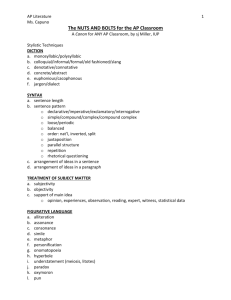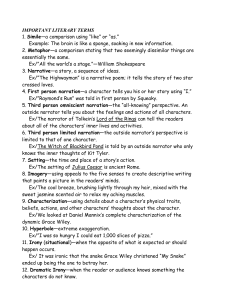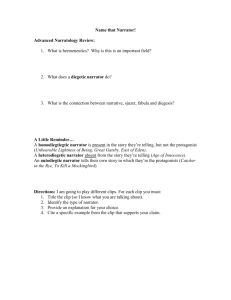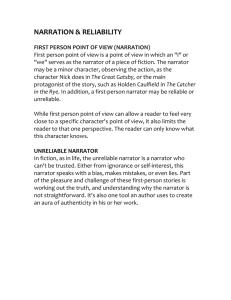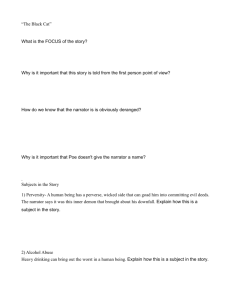The Nuts andBolts of Knowledge Neededfor the AP Test
advertisement
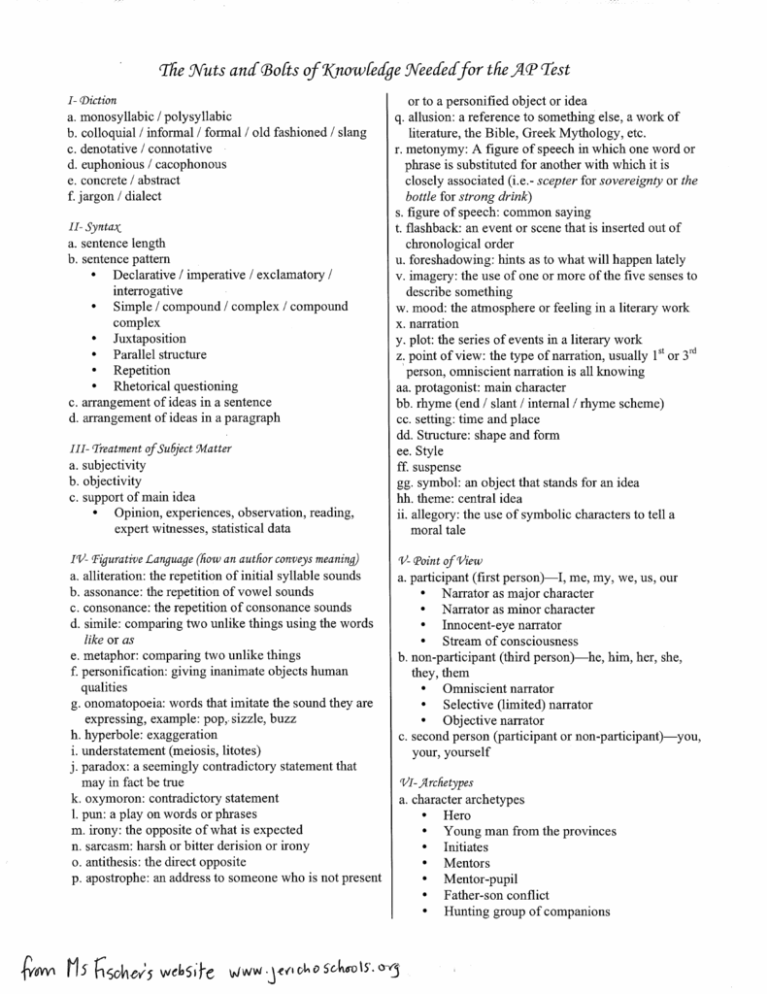
The Nuts andBolts of Knowledge Neededfor the AP Test I- Diction a. monosyllabic / polysyllabic b. colloquial / informal / formal / old fashioned / slang c. denotative / connotative d. euphonious / cacophonous e. concrete / abstract f. j argon / dialect H- Syntax a. sentence length b. sentence pattern ¯ Declarative / imperative / exclamatory / interrogative ¯ Simple / compound / complex / compound complex ¯ Juxtaposition ¯ Parallel structure ¯ Repetition ¯ Rhetorical questioning c. arrangement of ideas in a sentence d. arrangement of ideas in a paragraph III- Treatment of Subject Matter a. subjectivity b. objectivity c. support of main idea ¯ Opinion, experiences, observation, reading, expert witnesses, statistical data or to a personified object or idea q. allusion: a reference to something else, a work of literature, the Bible, Greek Mythology, etc. r. metonymy: A figure of speech in which one word or phrase is substituted for another with which it is closely associated (i.e.- scepter for sovereignty or the bottle for strong drink) s. figure of speech: common saying t. flashback: an event or scene that is inserted out of chronological order u. foreshadowing: hints as to what will happen lately v. imagery: the use of one or more of the five senses to describe something w. mood: the atmosphere or feeling in a literary work x. narration y. plot: the series of events in a literary work z. point of view: the type of narration, usually 1st or 3rd person, omniscient narration is all knowing aa. protagonist: main character bb. rhyme (end / slant / internal / rhyme scheme) cc. setting: time and place dd. Structure: shape and form ee. Style ff. suspense gg. symbol: an object that stands for an idea hh. theme: central idea ii. allegory: the use of symbolic characters to tell a moral tale IV- Figurative Language (’how an author conveys meaning) V- Point of View a. alliteration: the repetition of initial syllable sounds a. participant (first person)--I, me, my, we, us, our ¯ Narrator as major character b. assonance: the repetition of vowel sounds ¯ Narrator as minor character c. consonance: the repetition of consonance sounds d. simile: comparing two unlike things using the words ¯ Innocent-eye narrator ¯ Stream of consciousness like or as e. metaphor: comparing two unlike things b. non-participant (third person)--he, him, her, she, f. personification: giving inanimate objects human they, them ¯ Omniscient narrator qualities ¯ Selective (limited) narrator g. onomatopoeia: words that imitate the sound they are ¯ Objective narrator expressing, example: pop,. sizzle, buzz h. hyperbole: exaggeration c. second person (participant or non-participant)--you, i. understatement (meiosis, litotes) your, yourself j. paradox: a seemingly contradictory statement that may in fact be true VI- Archetypes k. oxymoron: contradictory statement a. character archetypes ¯ Hero 1. pun: a play on words or phrases ¯ Young man from the provinces m. irony: the opposite of what is expected ¯ Initiates n. sarcasm: harsh or bitter derision or irony ¯ Mentors o. antithesis: the direct opposite ¯ Mentor-pupil p. apostrophe: an address to someone who is not present ¯ Father-son conflict ¯ Hunting group of companions ¯ ¯ ¯ ¯ ¯ ¯ ¯ ¯ Loyal retainers Friendly beast Civil figure with good heart Scapegoat Outcast Devil figure Create of nightmare Woman figures-o Earth mother o Temptress ’ o Platonic ideal o Unfaithful wife o Damsel in distress b. symbolic archetypes ¯ Light vs darkness ¯ Water vs desert ¯ Heaven vs hell ¯ Innate wisdom vs educated stupidity ¯ Haven vs wilderness ¯ Supernatural intervention ¯ Magic weapon c. situational archetypes ¯ Quest-journey ¯ Task ¯ Initiation ¯ Journey- search for truth ¯ Fall ¯ Death and resurrection ¯ Nature vs mechanistic world ¯ Battled between good and evil ¯ Unhealable wound ¯ Ritual VII-Allusion a. personal b. biblical c. mythological d. historical e. literary to literary VIII- Themes Abuse / neglect Alienation Ambition Appearance vs reality Betrayal Bureaucracy Children Courage / cowardice Chance / fate / luck Cruelty / violence Custom / tradition Defeat / failure Despair / discontent / disillusionment Dreams / fantasies Domination / suppression Duty / allegiance / blind faith Escape / confinement Ethic vs morality / right vs wrong Exile / persecution Falsity / pretense / affectation Family / parenthood / deconstructed family Gender evolution The isms (prejudices: sexism, racism, classism, antiSemitism, sizism, ageism, lookism) Deconstructed family Free will / will power Greed Heaven / paradise / utopia Home Heart vs. reason Initiation Illusion / innocence Instinct Journey Law /justice / revenge Education / school Loneliness / alienation Materialism Memory / past Mob psychology Mysterious danger Nature vs. mechanistic world Persistence / perseverance Patriotism Poverty / class Prophecy Redemption / salvation Repentance Resistance / rebellion Revenge / retribution Ritual / ceremony Scapegoat /victim / suicide Media Search for self Time War ***A thematic statement = elevated diction + comment on book IX- Characterization (POV/narrator) What or where characters.., say, do, think, wear, are; with whom they associate, what others say about them Analyzing Tragedy and Tragic Fiction Aristolian Theory: unity of action catharsis tragedy (hubris) scene of suffering XI- Tone (Jeering/mood/attitude/effect) Lighthearted Confident Amused Complementary Hopeful Cheery Elated Passionate Exuberant Optimistic Sympathetic Proud Enthusiastic Loving Compassionate Indignant Foreboding Reverent Irreverent Diffident Contemptuous Angry Furious Irritated Accusing Disgusted Indignant Condemnatory Outraged Bitter Threatening Inflammatory Disdainful Formal Ceremonial Restrained Detached Objective Informative Candid Clinical Objective Questioning Instructive Matter-of-fact Admonitory Learned factual Didactic Informative Authoritative Incredulous Shocked Baffled Disbelieving Urgent Nostalgic Reminiscent Sentimental Whimsical Fanciful Scornful Sarcastic Critical Satiric Bantering Taunting Ironic Amused Patronizing Pompous Disdainful Cynical Facetious Sardonic Insolent Flippant Condescending Mock-heroic Whimsical Melancholic Mournful Apprehensive Despairing Foreboding Resigned Elegiac Sentimental Didactic Pedantic Disturbed Serious Fearful Sober Staid Somber Sad Solemn Concerned Gloomy Hopeless TP-CASTT A Way to Identify Poetic Devices T-TITLE: ponder the title before reading the poem P-PARAPHRASE: translate the poem for meaning beyond the literal and into your own words C-CONNOTATION: contemplate the poem for meaning beyond the literal A-ATTITUDE: observe both the speaker’s and poet’s attitude (tone) S-SHIFTS: note shifts in speaker’s and poet’s attitude T-TITLE: examine the title again--this time on an interpretive level T-THEME: determine whatthe poet is saying DIDLS A Way to Understand Poetry Through the Examination of the Author’s Tone or Attitude Towards the Subject D-DICTION: the connotation of word choice I-IMAGES: vivid appeals to understanding through the senses D-DETAILS: facts included or omitted L-LANGUAGE: overall use of language such as formal, jargon, clinical... S-SENTENCE STRUCTURE: how structure effects the reader’s attitude
